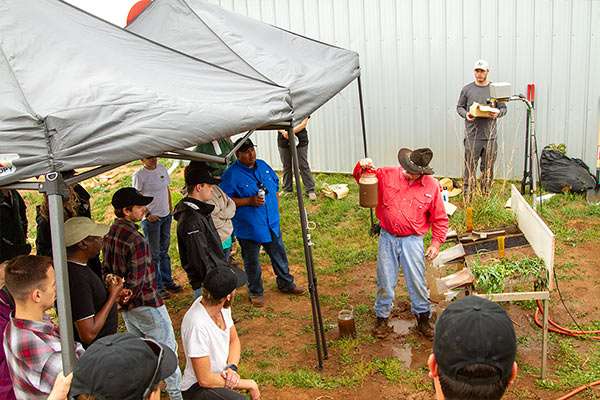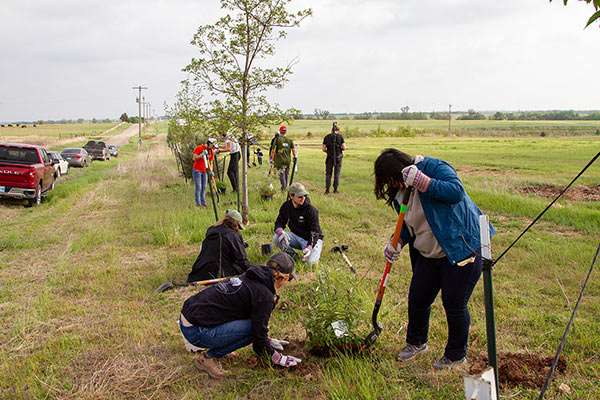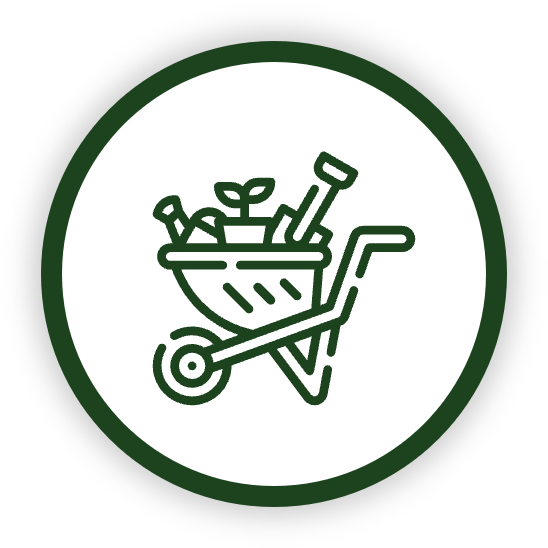2024 Q2 Impact Report
Letter from Founder and Team
Springtime in Oklahoma is a time of wild weather, and it is the rainy season. And this rainy season did not disappoint, with about 10” of rain. This rain was absolutely wonderful for helping all of the trees and pollinator plants we put in the ground this quarter get established. Although the timing was a bit late in the season to be ideal for some of the annual crops, it was overall beneficial for us this year.
This quarter we had an enthusiastic group out for a Farm Day. This group included both volunteers from our sister organizations, as well as students from the Oklahoma State University Environmental club. We got a presentation about the importance of soil health and cover crops from the Oklahoma Conservation Commission. And we even got a lot of pollinator plants planted, a natural fence built, and many bags of thistles dug up before we got chased offsite early by an approaching storm with tornadoes and hail! A record breaking 35 tornadoes touched down in Oklahoma, just following the Farm Day event into that night, making for quite an eventful trip for everyone.



This quarter also saw most of the border trees that hadn’t survived get replaced. These trees will provide a windbreak, as well as food and habitat for local wildlife. We planted milo, and also planted 3-acres of sunflowers by the Tiny house and an additional 3-acres of sunflowers in the northeast field. This will be good for the soil and bees, and hopefully will be a cash crop as well.
All pastures received fertilizer in the form of cattle manure this quarter, and some areas also received chicken litter.
Our projects are working to do good on multiple fronts: carbon sequestration, regenerating soil, make food for those in need, plant diverse crops for stability in changing times, and providing habitat to support our farm as part of the larger matrix of natural systems in the region.
We could not do our work without donors. Our foundation’s administrative costs are covered through sponsorship donations, and all other donations go directly to on the ground project actions.
Summary of Q2 Activities
Our donor-funded activities are broken down into 7 main categories. The activities completed during this quarter are outlined below:

University Involvement Support/ Science Projects
- Ongoing conversations with Oklahoma State University about participating in additional research projects, speaking events with students, and other opportunities for engagement.
- Planning for soil sampling sequestration assessment in 2025.

Diverse Planting
- Perennial:
-
- Blueberry garden removed
- We continued to care for the orchard trees.
- The remaining existing trees without support and protection also had t-post supports added.
-
- Annual:
-
- Sunflowers: 3-acres of oil seed sunflowers were planted near the Tiny House during and just after Farm Day. An additional 3-acres was planted in the northeast field.
- Milo: 16-acres of milo was planted in the northeast field.
- Wheat: Despite the good rains, the 33-acres of wheat development was sparse, and we determined that the crop is nitrogen limited, and will need additional supplemental nitrogen in future seasons. The late rains have also resulted in abundant green vegetation growing into the mature wheat, which made it unharvestable without chemical termination.
- Oats: 30 acres of oats were planted in Q1, and these are growing well, however they have been overtaken by the weedy species in this field. This field will not be able to be harvested due to the dominance of weedy species, and the vegetation will be burned as part of the IPM plan in Q3. See the IPM section below for additional details.
-

Livestock Incorporation
- Indirect Cattle and Chickens: This quarter, we incorporated livestock We obtained 220 tons of composted manure, and spread that over the wheat field, the oat field, and the barley cover crop.
- Direct Cattle: We also introduced 19 steers into the grassland portion May 24, 2024. An additional 60 steers were added in late May to implement mob grazing of this area, high intensity and short duration grazing. All but 11 of these 79 cattle were pulled off on June 18 when field was grazed to a bit over 1000 lbs/acre of residual dry matter (RDM), and those remaining will keep it around 1000 lbs/acre until they are pulled off as well.
- European Honeybees: We continued the supplemental feeding of the honeybees started in Q1 through May 24, when bees were foraging sufficiently on their own. We are having an issue with weedy species in the oat field directly adjacent to the honeybee hives. However, many of the weedy species, such as yellow sweet clover (Melilotus officinalis) are good for pollinators. The “Mel” in the genus name is even Latin for “honey” because they are good for honey production.

Cover Cropping
- Cover cropping is beneficial to regenerative farming in many ways. It protects the soil from erosion. Many species replenish essential nutrients, such as nitrogen, in the soil. This year we have three cover crops planted: Native grasses and barley from fall, and we have added hairy vetch this spring.
- Native grasses: The deep roots from native species also help sequester carbon. Our native grass cover crop around the orchard will continue to develop around the orchard, which will help with carbon sequestration, soil stabilization and retaining water in that soil. The native grass was seeded 2021, and the drought that year did result in limited establishment. There are some bunchgrasses still in that region, but they are not the dominant species of cover.
- Barley: This quarter the 20-acres of barley cover crop we planted in our east field developed and went to see. The intention behind this is so that in the early summer, before the barley seed has matured, we will roller/crimper this stand into a dense mulch to suppress the annual weeds. The mulch will also retain and slowly release nutrients as it decomposes over the course of the growing season. However, the rains started later this spring, resulting in sparse development of the barley. And the consistent late rains prohibited roller/crimping until well after the barley had gone to seed. So, we were not able to use the roller/crimper prior, and we planted the milo and sunflowers into the standing barley in June.
- Hairy vetch: We planted 13 acres of hairy vetch near the honeybee hives, parallel to the riparian area of our creek. Vetch is a nitrogen fixing plant, and as it grows, this plant will enrich our soil. The flowers will also provide an excellent source of nectar for our honeybee colonies to produce abundant honey with. If the hairy vetch is planted in the fall, it can be used as a mulch with the roller crimper similar to the Barley. However, as ours were planted in the spring this year, it never grew more than a couple of inches before being overtopped by the other weedy species in this field. If this cover is planted again, it must be planted in the fall to be effective.

Farm Equipment & Supplies
- We have continued to make good use of the farm equipment purchased in earlier quarters, to do farm work and planting at the most optimal times for us.
- The B.A.T.girl tractor got a leaky sunroof repaired, and the gator had a fuel tank recall repair, both under warranty.

Infrastructure
- We completed the replanting of the border trees around the Tiny House field.
- We planted a mix of native and ornamental shrubs and vines that are good for pollinators, that will fill in the understory of our border tree hedgerow. These were planted during the Farm Day event and just after.
- We installed 3 new water hydrants at better locations given the developments in the buildings and other infrastructure over the past two years.
- We have continued to develop a water catchment system, and met with contractors to design the catchment structure over the tank. We also got an estimate from an irrigation specialist with plans for an orchard irrigation system based on the water catchment tank.

Rainmaker Farm
- Ongoing monitoring of the Barn Owl Nest boxes Rainmaker Farm is using ecological pest management. There is no nesting evident yet, but there are signs of use (white wash etc.)
- We have been implementing a variety of Integrated Pest Management tools to manage the weedy or invasive species in our crops.
- Musk Thistle: The population of Musk Thistle has grown exponentially over the past two years. We used concentrated vinegar to treat the musk thistle again this year, but started when they were at the rosette stage. We did find that most musk thistle regenerated after this treatment, even multiple treatments that killed all vegetation treated at the time. The concentrated vinegar is not an effective permanent treatment either at the rosette stage or later stages of development. We also used volunteers to help dig up this species by the roots at the Farm Day, as well as staff time to continue to dig this species out by the roots. However, this population is now well established with thousands of plants, and we could not contain it mechanically with the man hours available this year. A much greater management effort will be needed to control it later this year and in future years. This year we did concentrate efforts on the northeast fields and the south fields, where we could fully remove the species. As the northwest field was not able to be controlled this year.
- Yellow sweet clover, horse weed, other: Weedy species have dominated the oat field this year, obscuring much of the crop. We are considering multiple management options, including repeated mowing or swathing and burning in the Q3.
Targets and Goal Tracking
We are on track to meet our targets and goals.
Next Steps
In Q3 2024 we anticipate the following:
-
- Invasive plant management is going to be a priority for all future quarters.
- Burning select fields for IPM for invasive plant species
- Weather station will be installed at the start of Q3
- Finalize Conservation Plan with NRCS
- Continue developing the water catchment system.
- Install orchard irrigation system
- Harvest from orchard
- Planting cool season crops
- Continue our outreach and education efforts.
